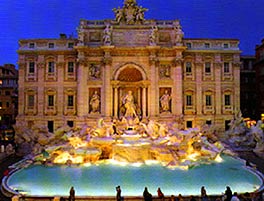|
|
 |
|
Trevi Fountain |
|
written
by Jennifer Lee / 07.04.2004 |
|
|
| |
Location |
| |
I visited Trevi Fountain three times. It is located just North of the Piazza Colona near the Spanish Steps, embedded in the wall with a church behind. The fountain is the mouth of the Aqua Virgo aqueduct.
|
| |
|
| |
|
| |
Connection to Research |
| |
Because I had researched the fountain and been intrigued by the variation in its appearance during the day and at night, I wanted to visit the fountain before the class went so that I could get a more individual perspective. I approached from the side during the day and saw a rock slab before me when I realized what I was seeing. Excited, I moved quickly to the center, pushing my way through the crowds of tourists that marred the view, and beheld the entire fountain for the first time.
I was surprised that the fountain, through large and ground, only had a single major pool and several very small streams of water trickling into the pool. From my previous research I had imagined the fountain to have many small pools that gracefully emptied into a grand pool full of coins. Despite the tourists and single pool, however, I was not disappointed by the fountain. Rather, I was enchanted by the careful sculptures and the seamless embedding of the fountain into the building.
Still full of tourists, the fountain seemed stifled by the swirl of color surroundings its serene blue water. I was glad to see the fountain with our class during a less crowded hour. The fountain appeared more majestic and relaxed when fewer tourists were crowding around it.
|
| |
|
| |
|
| |
Element of Interest |
| |
After conducting my initial research, I was intrigued by the coin-throwing tradition. I expected to see many tourists tossing coins over their shoulder, but when I visited, I was surprised to see no one doing this. I did follow the tradition, just in case there was some truth in it, and returned later that evening to photograph the fountain at night. When I returned during the evening, I still did not see tourists throwing coins.
This tradition caught my attention because it appeared in nearly every description of Trevi Fountain that I encountered. It is also featured in many movies, most recently the Lizzie Mcguire movie. The history of this ritual is also explained in A Thousand Bells at Noon, and so I looked forward to watching many people close their eyes and give wings to their currency.
When our class returned to the fountain earlier in the day, there were fewer tourists, but ironically, more people were tossing coins than when I had visited previously.
|
| |
|
| |
|
| |
Questions |
| |
My question was, "How does Trevi fountain compare to other fountains in Rome?"
After walking by several smaller fountains and seeing the exquisite sculptures wading in the fountains of Piazza Navona, I believe that the most distinguishing feature of the Trevi fountain is the size of the pool at its feet and the seamless flow from the fountain to the building wall itself.
The Trevi fountain opens into a large, clear blue body of water enclosed by stone banks. Other fountains, such as the central fountain in Piazza Navona, also have a general pool of water at the base of the fountain. However, the large size of the pool at the base of Trevi fountain, and its location in the front as opposed to in a circle surrounding the fountain, distinguish it from others.
Nearly all the other fountains I have viewed thus far are separate, stand alone structures that are not well related to, or camouflaged in, their surroundings. However, the Trevi fountain is built into the wall from which it stems, integrating it into the neighborhood and spilling forth with ebullient zest onto the piazza.
|
| |
|
| |
|
| |
Image Analysis |
| |
| |

|
|
| Trevi at night |
|
| |
|
This image shows the entire fountain at night. The glow of the lights on the water emphasize the pool and the central sculptures of the fountain. While the entire wall that makes up the fountain is well showcased, this image does not show the neighborhood surrounding the fountain, nor does it show the detail of the sculptures. The image puts great emphasis on the centerpiece of the work, with dim lighting for the top of the arch and the side sculptures that are equally as beautiful.
|
| |
|
| |
|
|
 |
|
